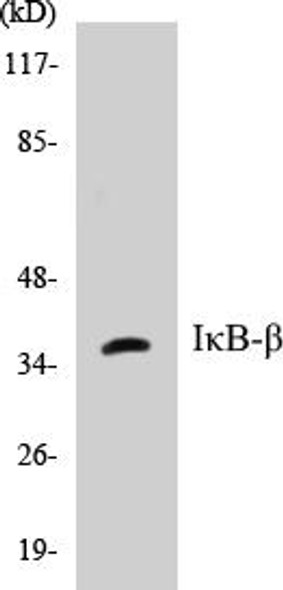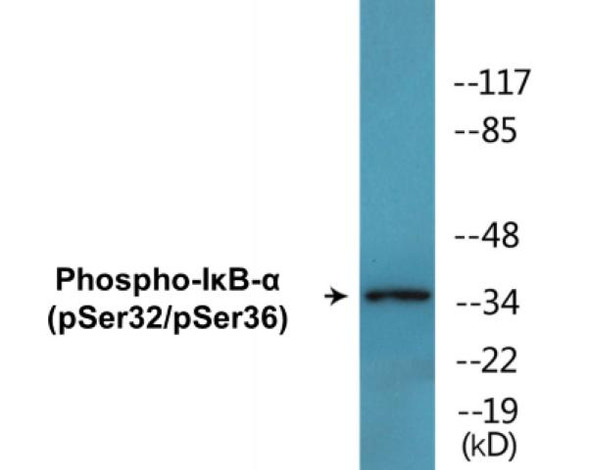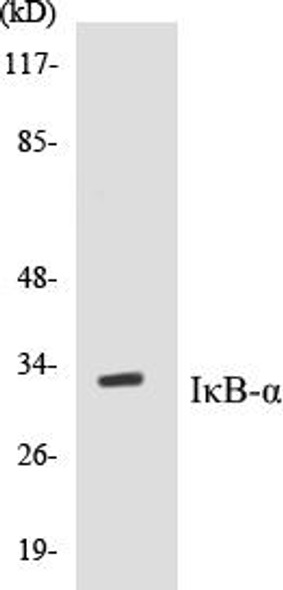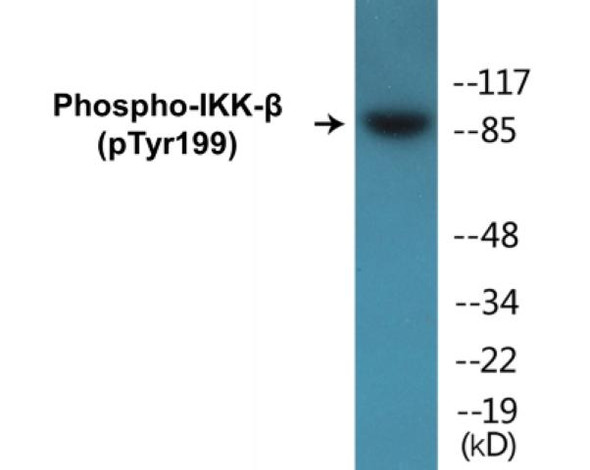IkappaB-beta (Phospho-Thr19) Colorimetric Cell-Based ELISA Kit
- SKU:
- CBCAB01275
- Product Type:
- ELISA Kit
- ELISA Type:
- Cell Based Phospho Specific
- Reactivity:
- Human
- Detection Method:
- Colorimetric
Description
IkappaB-beta (Phospho-Thr19)Colorimetric Cell-Based ELISA Kit
The IKKalpha/beta (Phospho-Thr19) Colorimetric Cell-Based ELISA Kit is designed for the accurate detection of phosphorylated IKKalpha/beta (Thr19) levels in cell lysates, serum, and plasma samples. This kit offers high sensitivity and specificity, ensuring reliable and reproducible results for researchers studying the NF-κB signaling pathway.IKKα and IKKβ are key regulators of NF-κB activation, playing a crucial role in inflammatory responses, immune function, and cell survival. Phosphorylation of Thr19 is known to modulate their activity, making it an important marker for understanding NF-κB signaling dynamics in various cellular processes.
With easy-to-follow protocols and quick assay turnaround times, the IKKalpha/beta (Phospho-Thr19) Colorimetric Cell-Based ELISA Kit provides researchers with a valuable tool for studying NF-κB signaling pathways and exploring potential therapeutic targets for inflammatory conditions, autoimmune diseases, and cancer.
| Product Name: | IkappaB-beta (Phospho-Thr19) Colorimetric Cell-Based ELISA |
| Product Code: | CBCAB01275 |
| ELISA Type: | Cell-Based |
| Target: | IkappaB-beta (Phospho-Thr19) |
| Reactivity: | Human |
| Dynamic Range: | > 5000 Cells |
| Detection Method: | Colorimetric 450 nm |
| Format: | 2 x 96-Well Microplates |
The IkappaB-beta (Phospho-Thr19) Colorimetric Cell-Based ELISA Kit is a convenient, lysate-free, high throughput and sensitive assay kit that can detect IkB-beta protein phosphorylation and expression profile in cells. The kit can be used for measuring the relative amounts of phosphorylated IkB-beta in cultured cells as well as screening for the effects that various treatments, inhibitors (ie. siRNA or chemicals), or activators have on IkB-beta phosphorylation.
Qualitative determination of IkappaB-beta (Phospho-Thr19) concentration is achieved by an indirect ELISA format. In essence, IkappaB-beta (Phospho-Thr19) is captured by IkappaB-beta (Phospho-Thr19)-specific primary (1ø) antibodies while the HRP-conjugated secondary (2ø) antibodies bind the Fc region of the 1ø antibody. Through this binding, the HRP enzyme conjugated to the 2ø antibody can catalyze a colorimetric reaction upon substrate addition. Due to the qualitative nature of the Cell-Based ELISA, multiple normalization methods are needed:
| 1. | A monoclonal antibody specific for human GAPDH is included to serve as an internal positive control in normalizing the target absorbance values. |
| 2. | Following the colorimetric measurement of HRP activity via substrate addition, the Crystal Violet whole-cell staining method may be used to determine cell density. After staining, the results can be analysed by normalizing the absorbance values to cell amounts, by which the plating difference can be adjusted. |
| Database Information: | Gene ID: 4793, UniProt ID: Q15653, OMIM: 604495, Unigene: Hs.9731 |
| Gene Symbol: | NFKBIB |
| Sub Type: | Phospho |
| UniProt Protein Function: | IkB-beta: a protein of the NF-kappa-B inhibitor family. Inhibits NF-kappa-B by complexing with and trapping it in the cytoplasm. However, the unphosphorylated form resynthesized after cell stimulation is able to bind NF-kappa-B allowing its transport to the nucleus and protecting it to further IKBA- dependent inactivation. Association with inhibitor kappa B- interacting Ras-like proteins 1 and 2 may also explain the slower degradation. Interacts with ligand-binding domain of thyroid hormone receptor-beta, inhibitor kappa B-interacting Ras-like protein 1, inhibitor kappa B-interacting protein Ras2, p65 (RELA) and c-Rel. Expressed in all tissues examined. |
| UniProt Protein Details: | Protein type:Inhibitor Chromosomal Location of Human Ortholog: 19q13.1 Cellular Component: cytosol; nucleus Molecular Function:protein binding; signal transducer activity; transcription coactivator activity Biological Process: transcription, DNA-dependent; MyD88-independent toll-like receptor signaling pathway; toll-like receptor 3 signaling pathway; signal transduction; toll-like receptor 10 signaling pathway; toll-like receptor 2 signaling pathway; activation of NF-kappaB transcription factor; MyD88-dependent toll-like receptor signaling pathway; toll-like receptor 5 signaling pathway; toll-like receptor signaling pathway; positive regulation of interferon type I production; innate immune response; toll-like receptor 9 signaling pathway; toll-like receptor 4 signaling pathway |
| NCBI Summary: | The protein encoded by this gene belongs to the NF-kappa-B inhibitor family, which inhibit NF-kappa-B by complexing with, and trapping it in the cytoplasm. Phosphorylation of serine residues on these proteins by kinases marks them for destruction via the ubiquitination pathway, thereby allowing activation of the NF-kappa-B, which translocates to the nucleus to function as a transcription factor. Alternatively spliced transcript variants have been found for this gene.[provided by RefSeq, Jul 2011] |
| UniProt Code: | Q15653 |
| NCBI GenInfo Identifier: | 57015399 |
| NCBI Gene ID: | 4793 |
| NCBI Accession: | Q15653.2 |
| UniProt Secondary Accession: | Q15653,Q96BJ7, A8K3F4, |
| UniProt Related Accession: | Q15653 |
| Molecular Weight: | 356 |
| NCBI Full Name: | NF-kappa-B inhibitor beta |
| NCBI Synonym Full Names: | nuclear factor of kappa light polypeptide gene enhancer in B-cells inhibitor, beta |
| NCBI Official Symbol: | NFKBIB |
| NCBI Official Synonym Symbols: | IKBB; TRIP9 |
| NCBI Protein Information: | NF-kappa-B inhibitor beta; ikB-B; TRIP-9; ikB-beta; ikappaBbeta; NF-kappa-BIB; I-kappa-B-beta; TR-interacting protein 9; thyroid receptor-interacting protein 9 |
| UniProt Protein Name: | NF-kappa-B inhibitor beta |
| UniProt Synonym Protein Names: | I-kappa-B-beta; IkB-B; IkB-beta; IkappaBbeta; Thyroid receptor-interacting protein 9; TR-interacting protein 9; TRIP-9 |
| Protein Family: | NF-kappa-B inhibitor |
| UniProt Gene Name: | NFKBIB |
| UniProt Entry Name: | IKBB_HUMAN |
| Component | Quantity |
| 96-Well Cell Culture Clear-Bottom Microplate | 2 plates |
| 10X TBS | 24 mL |
| Quenching Buffer | 24 mL |
| Blocking Buffer | 50 mL |
| 15X Wash Buffer | 50 mL |
| Primary Antibody Diluent | 12 mL |
| 100x Anti-Phospho Target Antibody | 60 µL |
| 100x Anti-Target Antibody | 60 µL |
| Anti-GAPDH Antibody | 60 µL |
| HRP-Conjugated Anti-Rabbit IgG Antibody | 12 mL |
| HRP-Conjugated Anti-Mouse IgG Antibody | 12 mL |
| SDS Solution | 12 mL |
| Stop Solution | 24 mL |
| Ready-to-Use Substrate | 12 mL |
| Crystal Violet Solution | 12 mL |
| Adhesive Plate Seals | 2 seals |
The following materials and/or equipment are NOT provided in this kit but are necessary to successfully conduct the experiment:
- Microplate reader able to measure absorbance at 450 nm and/or 595 nm for Crystal Violet Cell Staining (Optional)
- Micropipettes with capability of measuring volumes ranging from 1 µL to 1 ml
- 37% formaldehyde (Sigma Cat# F-8775) or formaldehyde from other sources
- Squirt bottle, manifold dispenser, multichannel pipette reservoir or automated microplate washer
- Graph paper or computer software capable of generating or displaying logarithmic functions
- Absorbent papers or vacuum aspirator
- Test tubes or microfuge tubes capable of storing ≥1 ml
- Poly-L-Lysine (Sigma Cat# P4832 for suspension cells)
- Orbital shaker (optional)
- Deionized or sterile water
*Note: Protocols are specific to each batch/lot. For the correct instructions please follow the protocol included in your kit.
| Step | Procedure |
| 1. | Seed 200 µL of 20,000 adherent cells in culture medium in each well of a 96-well plate. The plates included in the kit are sterile and treated for cell culture. For suspension cells and loosely attached cells, coat the plates with 100 µL of 10 µg/ml Poly-L-Lysine (not included) to each well of a 96-well plate for 30 minutes at 37 °C prior to adding cells. |
| 2. | Incubate the cells for overnight at 37 °C, 5% CO2. |
| 3. | Treat the cells as desired. |
| 4. | Remove the cell culture medium and rinse with 200 µL of 1x TBS, twice. |
| 5. | Fix the cells by incubating with 100 µL of Fixing Solution for 20 minutes at room temperature. The 4% formaldehyde is used for adherent cells and 8% formaldehyde is used for suspension cells and loosely attached cells. |
| 6. | Remove the Fixing Solution and wash the plate 3 times with 200 µL 1x Wash Buffer for five minutes each time with gentle shaking on the orbital shaker. The plate can be stored at 4 °C for a week. |
| 7. | Add 100 µL of Quenching Buffer and incubate for 20 minutes at room temperature. |
| 8. | Wash the plate 3 times with 1x Wash Buffer for 5 minutes each time. |
| 9. | Add 200 µL of Blocking Buffer and incubate for 1 hour at room temperature. |
| 10. | Wash 3 times with 200 µL of 1x Wash Buffer for 5 minutes each time. |
| 11. | Add 50 µL of 1x primary antibodies Anti-IkappaB-beta (Phospho-Thr19) Antibody, Anti-IkappaB-beta Antibody and/or Anti-GAPDH Antibody) to the corresponding wells, cover with Parafilm and incubate for 16 hours (overnight) at 4 °C. If the target expression is known to be high, incubate for 2 hours at room temperature. |
| 12. | Wash 3 times with 200 µL of 1x Wash Buffer for 5 minutes each time. |
| 13. | Add 50 µL of 1x secondary antibodies (HRP-Conjugated AntiRabbit IgG Antibody or HRP-Conjugated Anti-Mouse IgG Antibody) to corresponding wells and incubate for 1.5 hours at room temperature. |
| 14. | Wash 3 times with 200 µL of 1x Wash Buffer for 5 minutes each time. |
| 15. | Add 50 µL of Ready-to-Use Substrate to each well and incubate for 30 minutes at room temperature in the dark. |
| 16. | Add 50 µL of Stop Solution to each well and read OD at 450 nm immediately using the microplate reader. |
(Additional Crystal Violet staining may be performed if desired – details of this may be found in the kit technical manual.)










